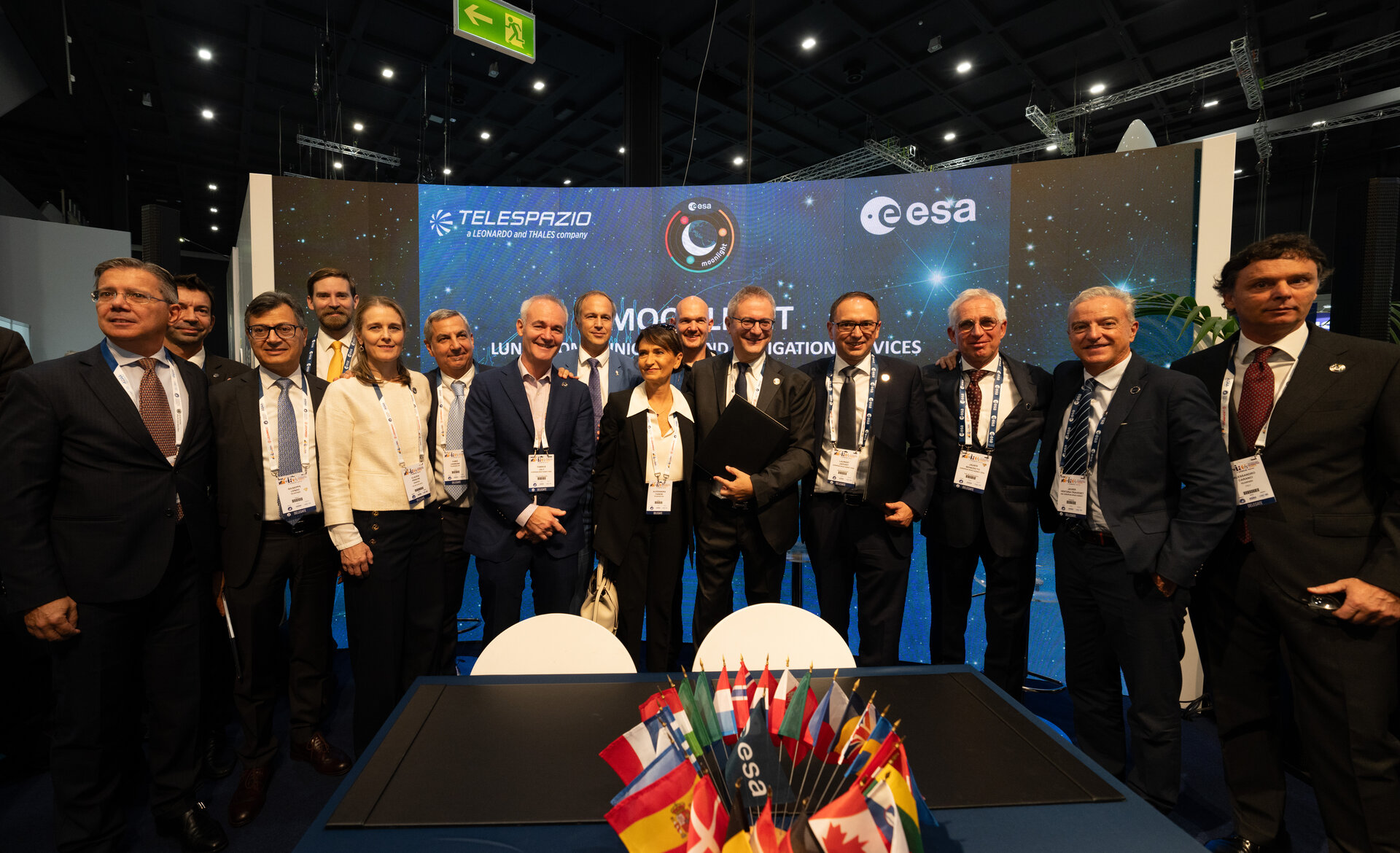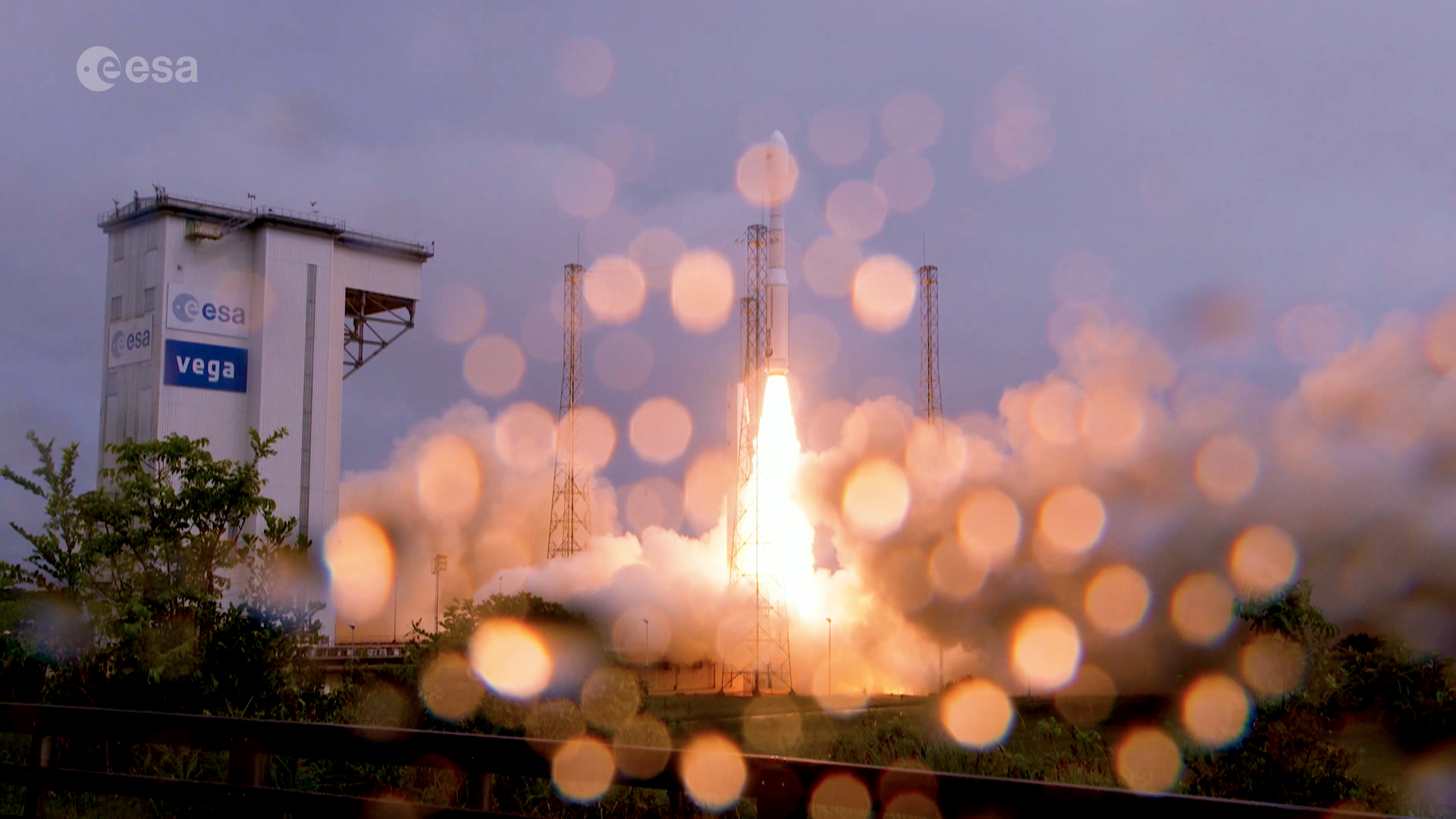15/10/2024
1300 views
26 likes
Imagine a near future where services such as satellite navigation, video conferencing, and file sharing are as seamless on the Moon as they are on Earth.
That’s the vision of ESA’s Moonlight programme, which aims to establish Europe’s first-ever dedicated satellite constellation for telecommunication and navigation services for the Moon. With over 400 planned lunar missions by space agencies and private companies in the next two decades, this programme marks a significant step towards sustainable lunar exploration and the development of a lunar economy.
The Moonlight Lunar Communications and Navigation Services (LCNS) programme is a partnership project between ESA and an industry consortium led by space systems developer Telespazio, with support from the UK and Italian Space Agencies. The programme will enable precise, autonomous landings and surface mobility, while facilitating high-speed, low-latency communication and data transfer between Earth and the Moon. This infrastructure is essential for humanity’s return to and long-term presence on the Moon, while enhancing efficiency and significantly reducing operational and user costs.
A satellite constellation for lunar navigation and connectivity
Moonlight will be a constellation of five lunar satellites (one for high data rate communications and four for navigation), launched into space and carried by space tug from Earth’s orbit to the Moon’s. The constellation will connect to Earth via three dedicated ground stations, creating a data network spanning up to 400 000 km.
The Moonlight LCNS satellites will be strategically positioned to prioritise coverage of the lunar south pole, an area suitable for future operations due to its advantageous terrain. This includes elevated areas or “peaks of eternal light” – ideal for solar power – and “craters of eternal darkness” containing polar ice – a potential source of water, oxygen and rocket fuel.
The first step in this ambitious programme is the Lunar Pathfinder, a communications relay satellite manufactured by Surrey Satellite Technology Ltd (SSTL) and set to begin operations in 2026. This pioneering spacecraft will serve as a precursor to the full LCNS constellation, providing commercial data relay services and testing existing Earth-orbiting navigation satellites for lunar use. Following the Lunar Pathfinder, Moonlight services will be gradually deployed, with initial operations by the end of 2028 and full operations by 2030.
Collaboration and future plans
ESA is working closely with NASA and JAXA on LunaNet, a new framework for lunar communication and navigation standards. LunaNet ensures compatibility with future lunar infrastructures and technologies, allowing our global customer base to benefit from the services for their own missions or deploy complementary technologies to enhance the network. Moonlight will comply with LunaNet’s standards and undergo the first-ever lunar navigation interoperability tests, scheduled for 2029.
In addition to other programmes, Moonlight will contribute to a multi-planetary future by supporting the testing of instruments and facilities in lunar conditions, helping us better understand their performance in environments other than Earth. Looking further ahead, ESA is taking early steps towards a Mars Communication and Navigation Infrastructure (MARCONI), leveraging the technologies and experiences gained from the Moonlight programme.
ESA officially commenced the Moonlight programme with a contract signing ceremony at the International Astronautical Congress (IAC) in Milan. The ceremony was attended by Laurent Jaffart, ESA Director of Connectivity and Secure Communications; Javier Benedicto, ESA Director of Navigation; Daniel Neuenschwander, ESA Director of Human and Robotic Exploration; and Gabriele Pieralli, Chief Executive Officer of Telespazio.
“ESA is taking the crucial step in supporting the future commercial lunar market, as well as ongoing and future lunar missions. We are extremely proud to be working with industry and Member States to ensure that our technological capabilities can support and foster cooperation on the Moon with our international partners,” said Josef Aschbacher, ESA Director General.
“This year saw the first commercial soft landing on the moon, and we expect there to be hundreds of new lunar missions launching over the next decade alone. With these missions will come increased demand for communications and navigation services which can be provided by commercial entities,” said Dr Paul Bate, Chief Executive of the UK Space Agency. “The growth of a commercial lunar economy can bring real benefits back to Earth and, as one of the two leading international investors in Moonlight alongside Italy, the UK is a strong supporter of the programme. We will work closely with ESA, Telespazio, SSTL and a range of other British companies to develop and deliver innovative commercial lunar services that serve institutional and private sector customers alike.”
“The launch of the Moonlight program is a cornerstone of Europe’s role in future lunar activities, as its telecommunications and navigation infrastructure will pave the way for future exploration missions and the growth of a lunar economy. Italy is proudly at the forefront of this endeavour, leveraging its industrial excellence and with the strong support from ASI, and is committed to playing a major role in establishing a sustainable presence on the Moon, in cooperation with our international partners,” said Teodoro Valente, President of the Italian Space Agency.
“Leading a prestigious pan-European team, Telespazio is committed to creating the conditions for a stable and secure presence on the Moon while simultaneously opening up extraordinary commercial opportunities for Europe in cis-lunar space,” said Gabriele Pieralli, CEO of Telespazio. “We are proud to play a crucial role in a program that will not only represent a key milestone in current and future space challenges but will also be a fundamental element in promoting synergies between ESA and other international space agencies.”
The Moonlight programme represents an ESA multi-directorate initiative, led by Connectivity and Secure Communications (CSC) with support from Navigation (NAV) and Human and Robotic Exploration (HRE), alongside industrial and institutional partners .



